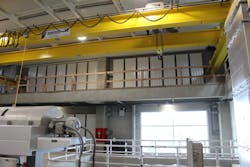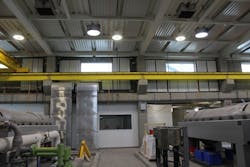Eckel Acoustic Panels Quiet the Harsh Mechanical Noise in Wastewater Treatment Plant Sludge Dewatering and Odor Reduction Building
The Orange County Sanitation District (OCSD), Huntington Beach, California provides wastewater collection, treatment, and disposal services for approximately 2.6 million people in central and northwest Orange County. OCSD operates two wastewater treatment plants in Huntington Beach, CA that process an average of 185 MGD (million gallons per day).
OCSD Plant #2 handles 65 MGD of the District’s wastewater stream. In the two-story Centrifuge Building, which went onstream in 2018, sludge dewatering and odor removal take place. Acoustic treatment was specified in order to reduce the excessively high sound level generated by a myriad of noise-producing equipment and comply with OSHA-designated guidelines. On the second floor, there are five Alfa-Laval G3 centrifuges, two to three of which are operated at any one time. The first floor features piston pumps, a plant air system with two 500 gal. air receiver tanks, exhaust fans, mechanical grinders, and a variety of other noisy pieces of equipment. Not quite as loud as the centrifuges on the second floor, but an acoustical hazard, nonetheless.
The two rooms have areas of 6,783 ft² (51 ft. wide x 133 ft. long), with the first floor having a ceiling height of 21 ft. The second floor has a two-level ceiling—one section is 11 ft. high, and the other is 21 ft. high. Most of the walls and floors are concrete, although there is some drywall on the second floor. The first-floor ceiling is concrete, while the second-floor ceiling is corrugated steel on the high roof and concrete on the low roof. That combination of loud industrial equipment, cavernous space, and highly reflective surfaces creates an acoustic nightmare that is hazardous to the health of operating personnel and decreases productivity because of the difficulty of person-to-person communications.
Brown & Caldwell (Walnut Creek, CA) created the specifications for the construction of the building. Included in the specs was the requirement that the ambient noise level in the plant be below 90 Db, and initially called for 50% of the wall and ceiling area to be treated with acoustic panels to try to meet that goal. Given the number of windows, the extent of the piping, the electrical utilities and the HVAC system, reaching that coverage goal was not possible. In the end, the acoustic noise reduction spec was achieved with panel coverage that worked out as follows: First floor walls—36.6%; first floor ceiling—19.6%; second floor walls—36.6%; and second floor ceilings—53.1%.
The layout of the panels in the building was done by Ryan Castle, Project Engineer with Shimmick Construction Co., Inc. (Huntington Beach, CA). While the standard size for Eckel panels in large room applications is 10 ft. x 30 in., they are available in a wide variety of sizes to accommodate specific wall and ceiling geometry to allow them to be installed around windows, doors, skylights, piping, utilities and HVAC units.
The final design called for a total of 702 perforated, v-ridged aluminum Eckel Functional Panels ranging in size from super-sized 48 in. x 120 in. panels down to 18 in. x 36 in. panels fabricated to fit in between wall obstacles. 149 panels were installed on the second-floor ceiling and 211 on the second-floor walls. On the first floor, 133 panels were installed on the ceilings, 95 on the walls, and 114 on the support columns. The panels were painted standard white.
The plant was started up and went operational before the panels were installed, so an anecdotal comparison could be made between the ambient noise level in the two rooms before and after panel installation.
According to Ryan Castle, “Before the panels were installed the plant was very loud and full of mechanical and operational echoes. All the moving parts and machinery could be heard everywhere as the sound just bounced back and forth off of all the empty space. The panels were then installed within the empty spaces on the walls, the columns, over some piping and conduit, on the ceilings, and around the HVAC systems. The panels helped trap the sound from reverberating off the empty spaces and the overall noise reduction was instantly noticeable. Before the panels, one could stand on one side of the building and hear all the machines and equipment throughout the building. After the panels were installed, the sound seemed to be isolated in its own region, and you can now no longer hear the equipment on either end of the building.”
Roger Francis, Resident Engineer at OCSD agrees, “Even if only one or two centrifuges were running, the noise generated reverberated throughout the second floor and made it unbearable. Once the panels were installed, there was quite a significant difference. Before, conversation on the second floor was impossible. Now you can have a conversation.”
While the first-floor equipment is not quite as loud as the centrifuges on the second floor, the panels on the first floor reduced the noise enough to allow clear communication.
Eckel acoustic panels are available in a wide range of sizes to accommodate the geometry, the obstacles and the sound reduction requirements of any specific industrial space. Available in aluminum, galvanized steel or stainless, they are durable and easily cleaned. They install easily with supplied brackets and can be attached to any wall or ceiling surface.
Editor's Note: Scranton Gillette Communications and the SGC Water Group are not liable for the accuracy, efficacy and validity of the claims made in this piece. The views expressed in this content do not reflect the position of the editorial teams of Water & Wastes Digest, Water Quality Products and Storm Water Solutions.

